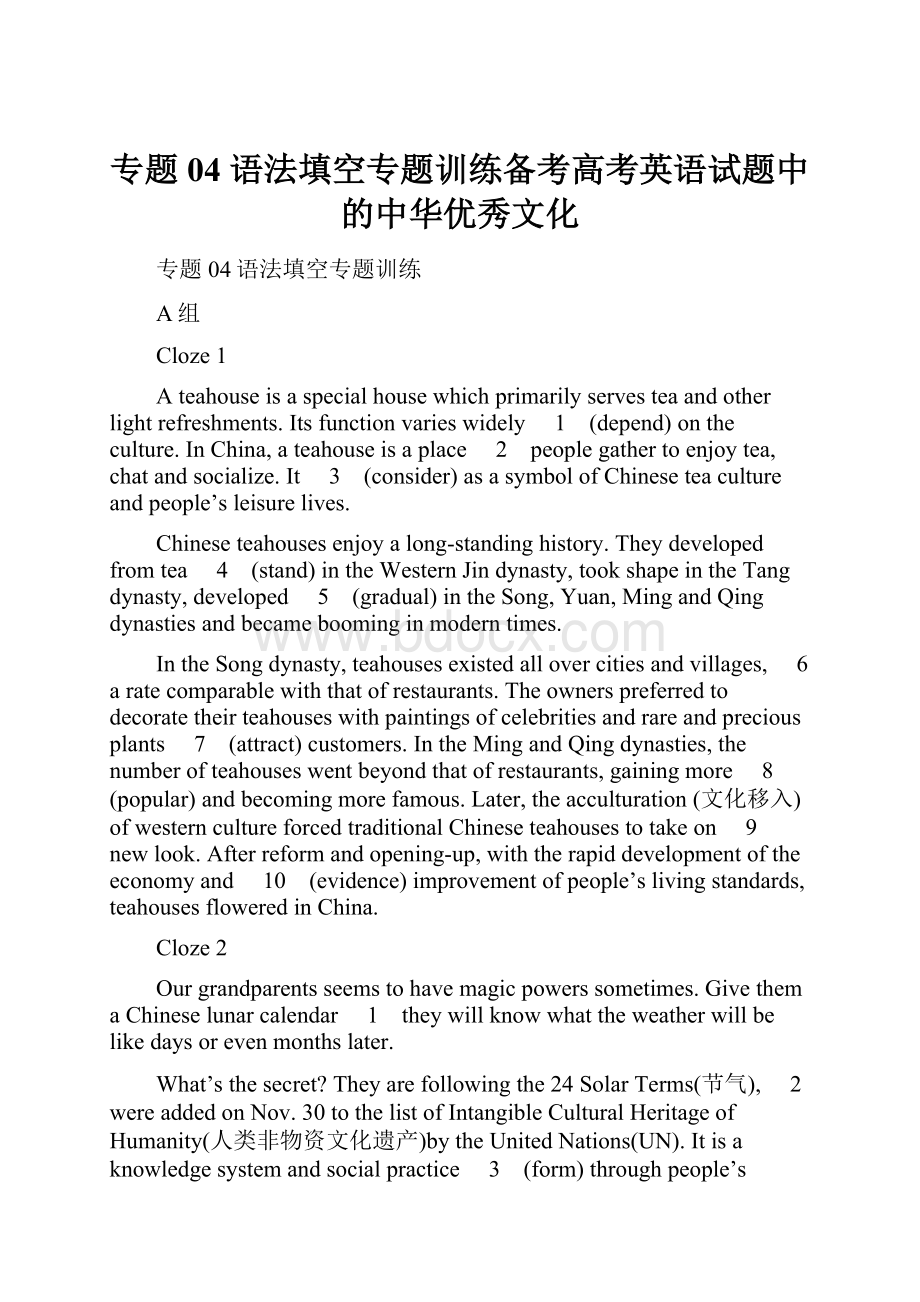专题04 语法填空专题训练备考高考英语试题中的中华优秀文化.docx
《专题04 语法填空专题训练备考高考英语试题中的中华优秀文化.docx》由会员分享,可在线阅读,更多相关《专题04 语法填空专题训练备考高考英语试题中的中华优秀文化.docx(16页珍藏版)》请在冰豆网上搜索。

专题04语法填空专题训练备考高考英语试题中的中华优秀文化
专题04语法填空专题训练
A组
Cloze1
Ateahouseisaspecialhousewhichprimarilyservesteaandotherlightrefreshments.Itsfunctionvarieswidely 1 (depend)ontheculture.InChina,ateahouseisaplace 2 peoplegathertoenjoytea,chatandsocialize.It 3 (consider)asasymbolofChineseteacultureandpeople’sleisurelives.
Chineseteahousesenjoyalong-standinghistory.Theydevelopedfromtea 4 (stand)intheWesternJindynasty,tookshapeintheTangdynasty,developed 5 (gradual)intheSong,Yuan,MingandQingdynastiesandbecameboominginmoderntimes.
IntheSongdynasty,teahousesexistedallovercitiesandvillages, 6 aratecomparablewiththatofrestaurants.Theownerspreferredtodecoratetheirteahouseswithpaintingsofcelebritiesandrareandpreciousplants 7 (attract)customers.IntheMingandQingdynasties,thenumberofteahouseswentbeyondthatofrestaurants,gainingmore 8 (popular)andbecomingmorefamous.Later,theacculturation(文化移入)ofwesterncultureforcedtraditionalChineseteahousestotakeon 9 newlook.Afterreformandopening-up,withtherapiddevelopmentoftheeconomyand 10 (evidence)improvementofpeople’slivingstandards,teahousesfloweredinChina.
Cloze2
Ourgrandparentsseemstohavemagicpowerssometimes.GivethemaChineselunarcalendar 1 theywillknowwhattheweatherwillbelikedaysorevenmonthslater.
What’sthesecret?
Theyarefollowingthe24SolarTerms(节气), 2 wereaddedonNov.30tothelistofIntangibleCulturalHeritageofHumanity(人类非物资文化遗产)bytheUnitedNations(UN).Itisaknowledgesystemandsocialpractice 3 (form)throughpeople’sobservationsofthesun’sannualmovementsanditsinfluenceontheclimate.
The24SolarTerms 4 (come)intobeingduringtheQinandHan 5 (dynasty).Atthattime,mostChinesepeoplemadetheirlivingonfarms,soweatherchangeswere 6 (extreme)importantforthem.Butofcourse,theyhadnosatellite,internetorweatherbroadcast 7 (help)them. 8 thesedifficulties,theymanagedtoworkout24SolarTermsbystudyingthesun’smovementandalso 9 (pay)attentiontoothernaturalchangessuchasairtemperature,waterandcropgrowth.
ItishonoredasChina’s 10 (five)greatinvention,afterpapermaking,printing,thecompassandgunpowder.Now,itisstillwidelyusedindailylifeevenintheageoftechnology-basedmodernfarming.
Cloze3
TheMid-AutumnFestivalinChinahasnothing,oratleastverylittle,todo 1 autumn.It’sabouttimeoffwork,andthegiftthatfewseemtoeatbutpeoplekeepgivingtooneanother:
mooncakes.
I 2 (learn)aboutmooncakeswhenImovedtoChina’scapitalcity,Beijing.WhentheMid-AutumnFestivalcamearound,thecitywas 3 (live)especiallywithshoppingformooncakes.Everygrocerystoreseemedtohavelinesofpeople 4 (carry)thatsingleitem(商品)tothecounter.IaskedmyChinesefriendsaboutmooncakes,and 5 majorityofthemsaidthatfewpeopleactuallyatethem.Instead, 6 (regard)asgifts,they’rechosenforfamily,friendsorco-workers.
WhenyearslaterImovedbacktoNewYorkCity,Ididn’texpecttofindanypublic 7 (celebrate)oftheMid-AutumnFestival.ButI’vebeensurprisedatthewaysthefestivalcontinuesinatleastthecity’s 8 (heavy)Chineseneighborhoods.ForweeksbeforetheMid-AutumnFestival,Brooklyn’sChinatown, 9 Ilive,looksalittlelikeBeijingwithpeoplerunninginandoutofChinesebakeries,orstandinginlineatChinesegrocerystorestobuymooncakes.
ItlookslikeChineseculturecan 10 (preserve),whileadaptingtochangingcircumstances.
Cloze4
TraditionalChinesecultureisbeginningtocapturetheattentionoftheworld.Kungfu, 1 (especial),hashadagreateffect 2 themillionsofpeoplewhofirstlearnedaboutChinathroughit.Fromthat,theymaycometoChinaandlearnaboutsomeother 3 (aspect)ofthisculture.OtherAsiannationshavelongknownaboutthe 4 (great)ofancientChineseculture.Theirownculturesare 5 mixofnativeonesandthoseChinesecharacteristics.KoreaandJapanlongagoadoptedConfucianism,somethingthatcontinuestodayevenasit 6 (challenge)bypopculture.Thisstrengthcomesfromtheideas 7 (give)intheFourBooksofConfucianism,whichbuiltupontheideasofaneven 8 (much)ancientperiodcodified(编纂)intheFiveClassics.Fromthem,theWestlearns 9 isuniquelyChinese,forexample,fengshui.SofarChinahastakensteps 10 (further)thisspreadofitsculturebyestablishingChineseCulturalCentersinsuchplacesastheUnitedStatesandEurope.
B组
Cloze1
TheGreatWallwasgrand,alittlerainyatfirst,butgrandallthesame.Themistcoveredthefarendsofthewall, 1 (give)itanalmostmysteriousfeeling.Thefogrolledinandoutofthehighmountains,revealingnewpartsofthewallas 2 (quick)asitcoveredthem.Ikeptonwalking,seeingwatchtowerafterwatchtower 3 myway.Tomy 4 (relieve),manypeoplehaddecidedtodaywasnotthebestday 5 (climb)thewall,andIwastherewithveryfewpeople.Iwalkedfor 6 seemedlikemiles.ThenIsawjusthowlongthewallIwasstandingonstretchedfor.
Itwas 7 (end)!
Iwalkedandwalked,butaftereveryhillIclimbed,therewasanotherlongstretchofwall.Ieventuallycameto 8 longstaircase.LaterIfoundoutthatit 9 (call)"ChairmanMao’sChallenge".Iaccepted,andafterclimbingthehundredplusstairstothepeak,IhadtoadmitthattheGreatWalltrulylivesuptoitsreputation.SoifI 10 (have)anotherchancetotraveltoChina,IwouldneverhesitatetovisittheGreatWallagain.
Cloze2
PekingoperaorBeijingoperaisaformofChineseopera 1 (combine)music,vocalperformances,danceandsoon.It 2 (arise)inthelate18thcenturyandbecame 3 (full)developedandrecognizedbythemid-19thcentury.Theformwasextremelypopularin 4 Qingdynastycourtandhascometoberegardedasoneofthe 5 (culture)treasuresofChina.Majorperformancetroupes(班子)arebasedinBeijingandTianjininthenorth,andShanghaiinthesouth.Also 6 (preserve)inTaiwan,theartformisstillofgreatimportancetopeoplethere.
7 (perform)ofPekingoperausetheskillsofspeech,song,dance,andcombat(搏斗)inmovementsthataresymbolicandsuggestive.Aboveallelse,theirskill 8 (evaluate)accordingtothebeautyoftheirmovements.ThemusicofPekingoperacanbedivided 9 theXipiandErhuangstyles.Therepertoire(全部曲目)ofPekingoperaincludesover1,400works, 10 arebasedonChinesehistory,folklore,and,increasingly,contemporarylife.
Cloze3
Canknots(结)beaformofart?
ItisinChina.Theyhavealonghistoryanda 1 (culture)meaningeventoday.
AChineseknotis 2 iswoven(编)fromasinglelengthofropetobeavarietyofshapes.Eachshapehas 3 (it)ownmeaning,andChineseknotsareusuallywovenintheredcolor,whichindicatesgoodfortune.
Originally,peoplemayhavemadethem 4 (record)informationandconveymessagesbeforetheystartedtowrite.Itisknownthatthey 5 (intend)forartisticdecorationandtoexpressthoughtsandfeelingsintheTangDynasty.TheTangEmpirewasalargeonethatcoveredmostofthe 6 (region)ofmodernChina,andsucceedinggenerationscarriedon 7 traditionalartformaspartoftheirculture.
Now,somepeopleuseknotswhentheydress 8 traditionalChineseclothing.Theyareameansof 9 (fasten)traditionalclothesinsteadofbuttons.Andsilkismost 10 (wide)usedtomaketheseclothingknots.
SeveralcountriesinAsiacelebratetheLunarNewYearintheirownway.ButdragonandliondancesinChinatownsallovertheworldhavehelpedtomakeChina’sNewYearthemostfamous.Thesedaysgrowing 1 (number)ofpeoplewhoarenotofChineseoriginarejoiningin.InTokyowindowcleanersdressupliketheanimalsoftheChineseShengxiao.America,CanadaandNewZealandhavepublishedmemorialstampsfortheyearoftherooster.LastyearNewYorkCitymadetheLunarNewYear 2 schoolholidayforthefirsttime.
ThespreadoftheSpringFestivalis 3 (part)duetorecentimmigrationfromChina:
9.5millionChinesepeople 4 (move)abroadsince1978,manyof 5 arefarricherthanearlierwavesofimmigrants.
Aware 6 China'sgrowingeconomicandpoliticalinfluence,foreignleadershavenoticedtheoccasion.Britain’sprimeminister,TheresaMay,hasgivenavideoaddress,atradition 7 (start)in2014byherpredecessor(前任).Thisyear’sWorldEconomicForuminDavoswasheldaweekearlierthanusual 8 (avoid)conflictingwithChina’sNewYear.
Chinahopesthefestivalwillpromote 9 (it)cultural“softpower”abroad.ItmaygivetheChinesepeople 10 (satisfy)toseeforeignersenjoysuchfestivities.
【参考答案】
A组
Cloze1
【文章大意】本文是一篇说明文,主要介绍了代表中国茶文化的茶馆的作用及其发展历史。
1.depending
【解析】考查非谓语动词。
茶馆的功能根据文化(的不同)而有很大的变化。
depend与其逻辑主语之间是主谓关系,故应用动词的-ing形式作状语。
2.where
【解析】考查定语从句。
茶馆是人们聚集在一起喝茶、聊天和进行社交的地方。
分析句子结构可知,空处引导定语从句,修饰先行词aplace,且在从句中作地点状语,故填where。
3.isconsidered
【解析】考查时态和语态。
它被看作中国茶文化和人们的闲暇生活的象征。
此处描述一般的客观事实,应用一般现在时;It与consider之间是动宾关系,应用被动语态。
故填isconsidered。
4.stands
【解析】考查名词的复数。
中国茶馆起源于西晋时期的茶摊。
本题难度较大,因为考生只知道stand作动词的用法,如果考生知道stand还可以作名词用,意为"货摊",且是可数名词,那就很容易填出stands了。
5.gradually
【解析】考查词性转换。
茶馆在宋朝、元朝、明朝和清朝逐步发展。
修饰动词developed应用副词,故填gradually。
6.at
【解析】考查介词。
以一种能与餐馆相媲美的速度。
rate多与介词at连用,表示"以……的速度",故填at。
7.toattract
【解析】考查非谓语动词。
分析句子结构及句意可知,空处在此作目的状语,故应用不定式形式。
8.popularity
【解析】考查词性转换。
在明朝和清朝,茶馆的数量超过了餐馆的数量,变得更受欢迎也更有名。
根据空前的"gainingmore"可知,此处应填名词popularity。
9.a
【解析】考查冠词。
西方文化的移入迫使中国的传统茶馆呈现出了新面貌。
look作"样子,外观"讲时是可数名词,且此处表泛指,故填不定冠词a。
takeonanewlook"呈现出新面貌"。
10.evident
【解析】考查词性转换。
改革开放以后,随着经济的快速发展和人们生活水平的显著提高,茶馆在中国遍地开花。
空处在句中作定语,修饰名词improvement,应用形容词evident。
Cloze2
【文章大意】文章介绍中国的24节气被增加到人类非物资文化遗产的名录中,介绍24节气的由来和重要性。
1.and
句意:
给他们一份中国农历,他们就会知道几天甚至几个月后的天气怎么样。
使用:
祈使